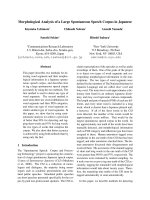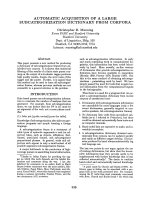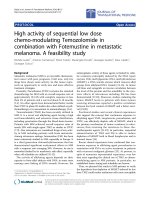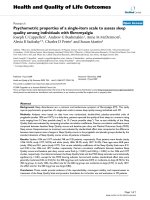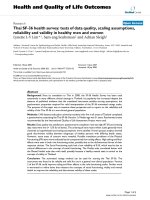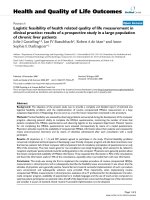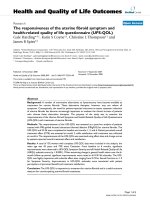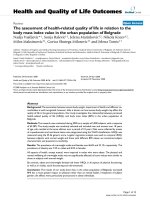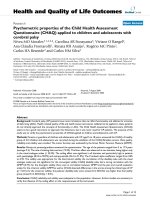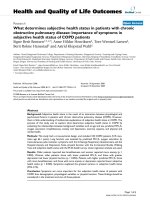báo cáo hóa học:" Logistic feasibility of health related quality of life measurement in clinical practice: results of a prospective study in a large population of chronic liver patients" pptx
Bạn đang xem bản rút gọn của tài liệu. Xem và tải ngay bản đầy đủ của tài liệu tại đây (282.53 KB, 9 trang )
BioMed Central
Page 1 of 9
(page number not for citation purposes)
Health and Quality of Life Outcomes
Open Access
Research
Logistic feasibility of health related quality of life measurement in
clinical practice: results of a prospective study in a large population
of chronic liver patients
Jolie J Gutteling
1,2
, Jan JV Busschbach
2
, Robert A de Man
1
and Anne-
Sophie E Darlington*
2
Address:
1
Department of Gastroenterology and Hepatology, Erasmus MC, 's Gravendijkwal 230, 3015 CE, Rotterdam, the Netherlands and
2
Department of Medical Psychology and Psychotherapy, Erasmus MC, Dr. Molewaterplein 50, 3015 GE Rotterdam, the Netherlands
Email: Jolie J Gutteling - ; Jan JV Busschbach - ; Robert A de
Man - ; Anne-Sophie E Darlington* -
* Corresponding author
Abstract
Background: The objective of the present study was to provide a complete and detailed report of technical and
logistical feasibility problems with the implementation of routine computerized HRQoL measurement at a busy
outpatient department of Hepatology that can serve as a tool for future researchers interested in the procedure.
Methods: Practical feasibility was assessed by observing problems encountered during the development of the computer
program, observing patients' ability to complete the HRQoL questionnaires, monitoring the number of times that
patients completed the HRQoL questionnaires and observing logistics at the outpatient department. Patients' reasons
for not completing the HRQoL questionnaires were assessed retrospectively by means of a mailed questionnaire.
Physicians' attitudes towards the availability of computerized HRQoL information about their patients were assessed by
means semi-structured interviews and by means of checklists administered after each consultation with s study
participant.
Results: All physicians (n = 11) and 587 patients agreed to participate in the study. Practical feasibility problems
concerned complicated technical aspects of developing a user-friendly computer program and safe data transmission over
the Internet, patients' lack of basic computer skills and patients' lack of compliance (completion of questionnaires on only
43% of the occasions). The main reason given for non-compliance was simply forgetting, which seemed to be related to
reception employees' passive attitude towards sending patients to the computer. Physicians were generally positive about
the instant computerized availability of HRQoL information. They requested the information in 92% of the consultations
and found the information useful in 45% of the consultations, especially when it provided them with new information.
Conclusion: This study was among the first to implement the complete procedure of routine computerized HRQoL
measurements in clinical practice and to subsequently describe the feasibility issues encountered. It was shown that the
attitudes of physicians were generally positive. Several barriers towards successful implementation of such a procedure
were encountered, and subsequently solutions were provided. Most importantly, when implementing routine
computerized HRQoL measurements in clinical practice, assistance of an IT professional for the development of a tailor-
made computer program, availability of questionnaires in multiple languages and the use of touch-screen computers to
optimise patient participation are essential. Also, all staff of the department concerned should approve of the intervention
and consider it as part of standard clinical routine if successful implementation is to be obtained.
Published: 10 November 2008
Health and Quality of Life Outcomes 2008, 6:97 doi:10.1186/1477-7525-6-97
Received: 28 August 2007
Accepted: 10 November 2008
This article is available from: />© 2008 Gutteling et al; licensee BioMed Central Ltd.
This is an Open Access article distributed under the terms of the Creative Commons Attribution License ( />),
which permits unrestricted use, distribution, and reproduction in any medium, provided the original work is properly cited.
Health and Quality of Life Outcomes 2008, 6:97 />Page 2 of 9
(page number not for citation purposes)
Background
The importance of patients' health related quality of life
(HRQoL) in medical practice is nowadays beyond dis-
pute. Two decades ago a committee of the American Col-
lege of Physicians specifically supported the view that
maintenance of a patient's functional well-being is a fun-
damental goal of medical practice. They also noted that
the assessment of the physical, psychological, and social
functioning of the patient in terms of the impact of dis-
ease is "an essential part of clinical diagnosis, a major
determinant of therapeutic choices, a measure of their
efficacy, and a guide in planning long-term care "[1].
Since 2001, several impact high impact articles have been
published on the effectiveness of HRQoL measurement in
clinical practice, which have presented positive results
such as more frequent discussion and identification of
HRQoL related problems, improved emotional function-
ing, improved HRQoL, a decrease in depression, a
decrease in debilitating symptoms, and expressed interest
in continued use of the information by both physicians
and patients [2-7]. Despite these positive results, standard
measurement and feedback of HRQoL has as of yet not
been widely implemented in clinical practice. This may be
explained by the initial lack of convincing data regarding
the effectiveness of standardized HRQoL measurement in
actually improving HRQoL or psychosocial outcomes
[3,8-11], and by practical and attitudinal barriers that
have been associated with the implementation of HRQoL
measurement in clinical practice. Practical barriers that
have been reported include general lack of time, money
and human resources, impracticality of instruments, dis-
ruption of clinical routine, lack of IT support and health
professionals' lack of knowledge in this area. Attitudinal
barriers may include health professionals' scepticism of
the validity of HRQoL questionnaires, and ability to inter-
vene should the questionnaires reveal any problems [11-
17].
To the best of our knowledge, only two studies have actu-
ally implemented the procedure of HRQoL measurement
in clinical practice and subsequently described the issues
encountered in terms of feasibility. In one of the studies,
the main finding was that higher compliance occurred
when the computerized data collection was integrated
into routine care. However, it should be noted that the fol-
low-up time was very short (12 weeks), resulting in a large
number of patients attending only once which makes it
difficult to draw any firm conclusions on patient compli-
ance in the long run [18]. In the other study, only 18
patients participated and the questionnaires were not
computerized [19]. A previous study has shown that pen-
and-paper versions of HRQoL questionnaires, which have
to be scored by hand, take too much time and are costly
in the long term [20]. Providing clinicians with instant
information about their patients' HRQoL at busy outpa-
tient clinics can only be obtained if this HRQoL is assessed
by means of computers that can generate an output which
can instantly be accessed by clinicians.
The aim of the present study was to gain more insight in
the practical and attitudinal feasibility problems encoun-
tered during the process of implementing computerized
HRQoL measurement at a busy outpatient department of
Hepatology (liver disease) (Erasmus MC, Rotterdam, the
Netherlands). Chronic liver disease is one of the most
prevalent diseases in the world, affecting over 560 million
people (
, 4-12-2006). It is a seri-
ous disease that is associated with impaired HRQoL
[21,22]. Chronic liver disease is an appropriate example
of a typical chronic disease, with patients experiencing
substantial comorbidity and possibly mortality as is the
case in many other chronic diseases.
This study was among the first to actually implement the
complete procedure of routine computerized HRQoL
measurement at an outpatient department, and to subse-
quently describe all feasibility issues encountered
throughout the process. The focus was on technical as well
as logistic feasibility issues such as optimization of patient
compliance in the long run, rather than effects of the
intervention on patient well-being which have been pre-
sented elsewhere [3-7]. Practical suggestions for research-
ers and health care workers interested in implementing
assessment of HRQoL in clinical practice were given.
Methods
Patient inclusion
This study was performed at the Department of Gastroen-
terology and Hepatology of the Erasmus Medical Centre
(Rotterdam, the Netherlands), which is one of three spe-
cialised centres for liver disease in the Netherlands. With
patients visiting the outpatient department on average
once every four months, the recruitment phase was set at
four months. Between September 2004 and January 2005
all patients of 18 years and older with chronic liver disease
(CLD) attending the department of Hepatology, and all
physicians working at the department of Hepatology,
were invited to participate in the study verbally and in
writing. Patients who agreed to participate received an
explanation of the purpose and procedure of the study
from the researcher, and consequently signed an
informed consent form. The protocol was in accordance
with the ethical guidelines of the modified 1975 Declara-
tion of Helsinki and approved by the Medical Ethics Com-
mittee of the Erasmus MC.
Study design and intervention
The first three months of the study consisted of a pilot-
testing phase during which problems with the use of the
Health and Quality of Life Outcomes 2008, 6:97 />Page 3 of 9
(page number not for citation purposes)
computer program were detected and solved by asking
patients to complete the online questionnaires. Patients'
opinions on the computerized questionnaires were
assessed by means of a pen-and-paper questionnaire that
was administered afterwards. This questionnaire included
the following questions: 'did you encounter any difficul-
ties completing the questionnaires? If so, what?, 'what do
you think of the time it took to complete the question-
naires?', and 'do you have any suggestions to improve the
computer program? ' After these three months, the actual
intervention started.
Physicians were randomly assigned to either the interven-
tion group (who had access to a graphical representation
of the HRQoL data of their patients) or the control group
(who conducted their consultations as usual). The physi-
cians in the intervention group were asked to use the
HRQoL data in all consultations for the duration of one
year. Physicians in both the control group and the inter-
vention group were asked to complete a checklist about
the content of the consultation after each consultation
with a participating patient.
All participating patients were asked to complete compu-
terized versions of a generic – (Short Form-12 [23]) and a
disease-specific HRQoL questionnaire (Liver Disease
Symptom Index 2.0 [24]), and the first part of a pen-and-
paper questionnaire on patient satisfaction with the con-
sultation, before each consultation (QUOTE-Liver [25])
for the duration of one year. After the consultation, they
completed the second part of the satisfaction question-
naire. For a more elaborate description of the study design
and intervention we refer to Gutteling et al. (2008)[7].
In order to optimise participation, study participants were
given instructions on the study procedure both verbally
and in writing at the beginning of the study, and eye-
catching posters were put up in the waiting room to
remind them of the study. In addition, the reception
employees were instructed to refer study participants to
the computer. With a study-duration of 1 year, it was esti-
mated that this would yield on average three measure-
ment moments per patient.
Measurement instruments
Practical feasibility
Practical feasibility of computerized HRQoL measure-
ment was assessed throughout the study by a) observing
problems encountered during the development of the
computer program which had to include several crucial
specifications (instant scoring and graphical output of the
data, instant availability of data to physicians, guaranteing
patient privacy) b) by observing patients' ability to com-
plete the HRQoL questionnaires and discussing any
encountered difficulties. c) by monitoring the number of
times that patients completed the HRQoL questionnaires.
d) by observing logistics at the outpatient department on
a daily basis. The observations were done by the main
researcher on this project.
A questionnaire was administered retrospectively to assess
participants' reasons for not completing the HRQoL
assessments in the clinic. This questionnaire included the
following questions: 1) Did you complete the question-
naires with each visit during the past year?, and 2) If not,
please indicate why not. This last question had several
response categories of which more than one could be
checked: a) I forgot to complete the questionnaires, b) I
was too late, or there was not enough time before the con-
sultation to complete the questionnaires, c) I did not feel
like completing the questionnaires, d) I was too ill to
complete the questionnaires and e) other
Attitudinal barriers
Attitudinal barriers of physicians were explored by semi-
structured interviews with all physicians that were con-
ducted midway through the study and at the end of the
study. In these interviews physicians were asked, amongst
others, whether they would be interested in continued use
of the information and whether there were any items that
they would like to be included in future versions of the
computer program.
Secondly all physicians in the experimental group were
asked to complete a checklist at the end of a consultation
of each participating patient, which consisted of four
important questions:, a) Did you request the HRQoL
information?, b) Did you use the information? c) Did you
find the information useful? and d) Why (not)?
Attitudinal barriers on the part of the reception employees were
inventorized while observing the process of care at the
outpatient department on a daily basis.
Data analysis
The retrospective questionnaire administered to patients
on reasons for not completing the assessment at the clinic
and the checklist completed by physicians after each con-
sultation were analysed quantitatively in SPSS 11.0, in
terms of frequencies and percentages. Descriptive data is
presented on the observed practical feasibility. Descriptive
data on the interviews with physicians, which were
intended to provide global information about physicians'
experiences with, and opinions on, the HRQoL informa-
tion, is also presented.
Results
Patients' and physicians' characteristics
All physicians working at the department of Hepatology
(n = 11, 10 = male, 1 = female) agreed to participate in the
Health and Quality of Life Outcomes 2008, 6:97 />Page 4 of 9
(page number not for citation purposes)
study. Their mean age was 39 years (range 27–55). The
average working experience of the physicians was 8.7
years (range 0 – 27 years). Five hundred and eighty seven
patients gave informed consent to participate (Figure 1) of
which 327 completed the measurements once or more.
260 patients who had consented to participate did not
complete the measurements once. Demographic charac-
teristics of the 327 participants are presented in Table 1,
and comparisons were made with the 260 non-respond-
ers.
Practical feasibility
Problems encountered during the development of the computer
program
Developing a tailor-made computer program that met our
needs with regard to the inclusion of our questionnaires
of choice, lay-out, and instant availability of computer-
ized graphical representations of the results to the physi-
cians without violating patients' privacy, proved to be
time-consuming and more costly than planned. Initially,
we attempted to develop the computer program display-
ing the questionnaires with basic available computer pro-
grams (such as Microsoft Access). This eventually proved
to be too complicated considering all the requirements
outlined above that had to be met. Expertise of an IT pro-
fessional was required. Finding an IT professional with
the appropriate skills to develop the program cost several
months as did the actual development of the final pro-
gram. In terms of finances there are costs attached to the
development of the program, the purchase of a domain
name and airing the website where the questionnaires
could be completed. During the pilot testing phase, we
discovered that administering the Short Form-36, the
complete LDSI 2.0 and the complete first part of the
QUOTE-Liver interfered with clinical routine. Even
though patients did not report negative evaluations
regarding the length of the questionnaires, we included
shorter versions of the questionnaires in the actual trial in
order not to disrupt clinical routine [7]. Completion time
was now on average 7.5 minutes, which we found accept-
able since it did no longer interfere with clinical routine.
Patients' ability to complete the HRQoL questionnaires
During the pilot testing phase, problems with patients'
basic computer skills such as mouse handling, scrolling
and entering digits in a designated field became apparent.
Table 1: Demographic characteristics of patients in the study
Respondents
(n = 327)
Non-respondents
(n = 260)
P
Gender (n, %)
Women 144 (44) 108 (76) 0.46
Men 183 (56) 135 (42)
Age (mean, range) 48.1 (20–81) 47.4 (18–80) 0.70
Diagnosis (n, %)
Hepatitis B 47 (14) 43 0.00
Hepatitis C 47 (14) 54
Cholestatic liver disease 33 (10) 31
Pre-transplantation 18 (6) 1
Post-transplantation 110 (34) 52
Auto-immune hepatitis 23 (7) 16
Other 49 (15) 47
Disease Severity (n,%)
No cirrhosis 206 (63) 153 (63) 0.95
Compensated cirrhosis 87 (27) 63 (26)
Decompensated cirrhosis 34 (10) 28 (11)
Nationality (n, %)
Dutch 270 (83) 207 (85) 0.54
Moroccan 5 (2) 2 (1)
Turkish 7 (2) 7 (3)
Surinam 10 (3) 4 (2)
Europe other 6 (2) 4 (2)
World other 25 (7) 20 (7)
Unknown 4 (1) 0 (0)
Differences were assessed by means of Chi-square tests (except for age: t-test)
Health and Quality of Life Outcomes 2008, 6:97 />Page 5 of 9
(page number not for citation purposes)
Some patients were not able to perform these skills.
Although participants with such limited knowledge of
computers formed a minority, they required substantial
assistance. The computer program used in the trial was
amended in order to overcome these problems by, as sug-
gested by the patients participating in the pilot testing
phase, making checkboxes larger and the entry field for
the patient number more easily identifiable. Also, a
mouse pad was used that provided step-by-step instruc-
tions for the completion of the questionnaires. These
improvements did not visibly improve patient participa-
tion. The mouse pad was mostly ignored, and entering the
patient number remained difficult, mostly because
patients did not know their number (estimation of 1/2).
Basic mouse handling also remained problematic for a
significant amount of patients (estimation of 1/5), which
consequently required substantial assistance.
HRQoL questionnaire completion rate
At the end of the study, the HRQoL assessment in the
clinic had occurred on 43% of the occasions (756 times
out of the estimated 1761 times, which is a rough estima-
tion based on the assumption that patients visited the out-
patient department on average three times during the
study (587 × 3 = 1761)). 260 participants never com-
pleted the HRQoL assessment on the computer at all, of
which 16 due to substantial language problems. Only 105
patients completed the HRQoL questionnaires three times
or more (Table 2). A retrospective exploration of the rea-
sons for this low response rate was performed by means of
a mailed questionnaire (response rate = 55%, 170 males,
145 females, mean age 50.0 years). The main reason that
was given for not completing the retrospective question-
naires was 'simply forgetting'. Other important reasons
included 'no time' and 'did not feel like it'. Less often, rea-
sons such as 'the computer was broken', 'there was no-one
there to help me complete the HRQoL questionnaires',
'no-one told me to complete the HRQoL questionnaires'
and 'the computer was occupied', were given. For an over-
view of all reasons given we refer to Figure 2.
Logistical issues
Logistical issues that were observed at the outpatient
department were forgetfulness of the reception employees
to send patients to the computer, and the computer being
out of sight of the waiting room area.
Patients in the studyFigure 1
Patients in the study.
Table 2: Number of times that patients completed the
questionnaires
Times that questionnaires were completed
1 2 3 456789>9
Patients (n) 327 181 105 58 33 20 13 10 5 4
Health and Quality of Life Outcomes 2008, 6:97 />Page 6 of 9
(page number not for citation purposes)
Attitudinal barriers
Interviews with physicians
The interview data showed that all physicians would like
to use the HRQoL information again in the future, espe-
cially for patients awaiting liver transplantation, patients
with HCV, and non-native speakers (mostly patients with
HBV). They suggested embedding the information in the
existing patient information system, and adding a screen-
ing tool for depression, especially for patients with HCV
and/or patients awaiting liver transplantation, diagnostic
questions (e.g. allergies, use of medication), questions
about the social situation of younger people (e.g. school,
friends, pass-times), and questions about expectations of
the consultation.
Physician checklists
The physicians in the experimental group requested the
information in 92% of the consultations, discussing it
with their patients in 58% of the consultations. They indi-
cated finding the HRQoL information useful in 45% of
the consultations, mostly because it provided new infor-
mation, but also because it saved time and because it con-
firmed the verbal information and their own clinical
impressions of patients who were doing well physically.
These last two statements were also relevant for the one
physician who claimed to know his patients well and did
therefore not find the HRQoL information particularly
useful. All physicians found the information less useful
when patients were doing well, when they knew patients
well and when patients were very talkative (Figure 3).
Observations
Attitudinal barriers were encountered on the part of the
reception employees. Their busy schedule did not allow
for much time to identify study participants and refer
them to the computer. The importance to do so was not
clear to them, and when no firm instructions were given,
they often forgot to send patients to the computer.
Advice
The most important advice to improve HRQoL measure-
ments in clinical practice that resulted from the current
study is summarized in Table 3.
Discussion
The present study is, to the best of our knowledge, the first
to describe a variety of feasibility issues encountered dur-
ing the implementation of computerized HRQoL meas-
urement in clinical practice, in a population of patients
with chronic liver disease. Feasibility problems concern-
ing technical aspects of developing a user-friendly compu-
ter program with safe data transmission over the Internet,
Participants' reasons for not completing the questionnairesFigure 2
Participants' reasons for not completing the questionnaires.
Health and Quality of Life Outcomes 2008, 6:97 />Page 7 of 9
(page number not for citation purposes)
Physicians' evaluations of the HRQoL informationFigure 3
Physicians' evaluations of the HRQoL information.
Table 3: Advice to improve HRQoL measurements in clinical practice
Technical issues
• For psychometric purposes, computerized questionnaires should resemble pen-and-paper versions as closely as possible
• Hire an IT expert
• Allow for development costs
Logistical issues
• Location in the vicinity of the waiting room area (ideally the computer can be seen from the waiting room area)
• Enough privacy
• Availability of internet/network connection
• Easily accessible to patients
Optimal patient participation
• use of a touch-screen computer
• very easy log-on procedure, eg. scanning the patient's punch card
• questionnaires in multiple languages
• short questionnaires
• HRQoL assessment is considered part of clinical routine
• Physicians and front desk employees ask patients to complete the questionnaires
Optimal physician participation
• HRQoL data embedded in the existing patient information system
• Add screening for depression
• Bring in a local clinical leader as a spokesman for the importance of HRQoL measurement
• Provide clear data output and clear instructions on how to interpret the data
• Make clear that the data should not be used as clear cut-off points for treatment of referral decisions, but rather as a base for more directed
discussion of psychosocial topics
• Provide management options
Health and Quality of Life Outcomes 2008, 6:97 />Page 8 of 9
(page number not for citation purposes)
patients' computer skills, and patients' compliance were
encountered. Physicians were generally positive about the
instant computerized availability of HRQoL information.
Technical problems that we encountered during the devel-
opmental phase of the computer program were substan-
tial, and cost substantial time and effort to correct.
Assistance from an IT professional is advised if one
intends to develop a computer program that includes the
particular questionnaires of interest, is easy for patients to
complete, and transmits the information to the physi-
cians' computer in such a way that privacy is assured.
With regard to patients' lack of basic computer skills, the
use of touch-screen computers, which have been shown to
be easy to handle by various patient populations [20,26-
30], is recommended when implementing HRQoL meas-
urement in clinical practice. This may optimise patient
participation, and the quality of the answers, which will
be less biased by the presence of family members or
friends that help with completing the questionnaires such
as found in the study of Velikova et al (2002) [31].
A limitation of the present study was the high number of
non-participants. Part of the explanation may lie in the
fact that patients themselves were responsible for contact-
ing their physician if they were interested in participating
in the study. In addition, the number of non-Dutch speak-
ing patients visiting the department of Hepatology of the
Erasmus MC is relatively large (Hepatitis B for example, is
most common among people from North Africa). These
patients were also invited to partcipate, but were not able
to participate since the questionnaires in this study were
only available in Dutch. Future studies should aim at
including non-native speakers, whose data are of particu-
lar interest to the physicians in this study.
The low compliance of patients that did participate in our
study, is in accordance with findings of a previous study
showing deterioration of compliance with longer follow-
up [17]. Bad timing and other priorities were given as pos-
sible explanations. In our study, an explanation may lie in
the small window of opportunity to complete the ques-
tionnaires before each consultation. Indeed, patients
mentioned in the retrospective questionnaire that lack of
time was one of the main reasons for not completing the
questionnaires. Simply forgetting to complete the ques-
tionnaires was the most important reason, despite eye-
catching posters that were put up in the waiting room. The
fact that the retrospective question "have you completed
the questionnaires with each visit" was answered with
"no" in 57% of the cases supposes an honest attitude of
the respondents, who were informed about the anonym-
ity of their responses. Considering these results, it seems
that patient participation cannot be left to patients them-
selves, who may be nervous about the upcoming consul-
tation and/or used to going to the waiting room after
announcing themselves at the reception desk. To optimise
participation it is, in our opinion, of vital importance that
all staff of the department concerned, especially the recep-
tion desk personnel but also the nurses and physicians,
approves of the intervention, considers it as part of stand-
ard clinical routine, and acts accordingly by sending
patients to the computer before each consultation.
The positive attitudes of the physicians in our study
towards the availability of instant computerized HRQoL
information during the consultation are in accordance
with previous studies in oncology [18,30], and advocate
the continued use of such a procedure in patients with
chronic liver disease. However, future studies should aim
at including more liver specialists in order to substantiate
these findings. Expressed concerns of an increase in work-
load as a result of the HRQoL data [30] were absent in our
study. These positive findings in liver specialists, treating
patients with a disease that is generally less acute and life
threatening than cancer for instance, give incentive to fur-
ther exploration of routine computerized HRQoL meas-
urement in other specialisations within internal medicine
such as nephrology or gastroenterology. When imple-
menting such a procedure, it should be stressed to physi-
cians that standardized HRQoL information should never
replace the clinical dialogue between patient and physi-
cian, as important symptoms may then be overlooked, or
exaggerated [30]. Rather, the HRQoL information should
be seen as an indication of possible problems worth dis-
cussing and exploring further during the consultation.
Conclusion
This study addressed practical feasibility issues associated
with routine computerized measurement of HRQoL at a
busy outpatient department of Hepatology. Feasibility is
an important requirement for more widespread imple-
mentation of such an intervention. Another requirement
is that the intervention is effective in improving patients'
well-being and/or medical treatment. The current study
has directly contributed to the first requirement by show-
ing that the attitudes of physicians were generally positive,
by identifying probable barriers towards successful imple-
mentation, and by providing solutions on how to over-
come these barriers. These include hiring an IT expert,
involving all personnel and using touch-screen comput-
ers. While the findings of the current study are encourag-
ing they also emphasise that these implementation
processes are complex and should not be underestimated.
Further studying of the feasibility and effectiveness of rou-
tine computerized HRQoL measurements in clinical prac-
tice is needed before widespread implementation can be
achieved.
Publish with BioMed Central and every
scientist can read your work free of charge
"BioMed Central will be the most significant development for
disseminating the results of biomedical research in our lifetime."
Sir Paul Nurse, Cancer Research UK
Your research papers will be:
available free of charge to the entire biomedical community
peer reviewed and published immediately upon acceptance
cited in PubMed and archived on PubMed Central
yours — you keep the copyright
Submit your manuscript here:
/>BioMedcentral
Health and Quality of Life Outcomes 2008, 6:97 />Page 9 of 9
(page number not for citation purposes)
Competing interests
The authors declare that they have no competing interests.
Authors' contributions
JG participated in the design of the study and conducted
it. She also drafted the manuscript. RDM participated in
the design of the study and helped to conduct it. JB and
ASD participated in the design of the study and helped to
draft the manuscript. All authors read and approved the
final manuscript.
Acknowledgements
The authors would like to thank all patients and physicians for their active
participation in the study.
References
1. Position Pape: Comprehensive functional assessment for eld-
erly patients. Health and Public Policy Committee, Ameri-
can College of Physicians. Ann Intern Med 1988, 109:70-72.
2. Lohr KN: Applications of health status assessment measures
in clinical practice. Overview of the third conference on
advances in health status assessment. Med Care 1992, 30(5
Suppl):MS1-14.
3. Detmar SB, Muller MJ, Schornagel JH, Wever LDV, Aaronson NK:
Health-related quality-of-life assessments and patient-physi-
cian communication: a randomized controlled trial. JAMA
2002, 228(23):3027-3034.
4. McLachlan SA, Allenby A, Matthews J, Wirth A, Kissane D, Bishop M,
Beresford J, Zalcberg J: Randomized trial of coordinated psy-
chosocial interventions based on patient self-assessments
versus standard care to improve the psychosocial function-
ing of patients with cancer. J Clin Oncol 2001, 19(21):4117-25.
5. Velikova G, Booth L, Smith AB, Brown PM, Lynch P, Brown JM, Selby
PJ: Measuring quality of life in routine oncology practice
improves communication and patient well-being: a rand-
omized controlled trial. J Clin Oncol 2004, 22(4):714-24.
6. Boyes A, Newell S, Girgis A, McElduff P, Sanson-Fisher R: Does rou-
tine assessment and real-time feedback improve cancer
patients' psychosocial well-being? Eur J Cancer Care [Engl] 2006,
15(2):163-71.
7. Gutteling JJ, Darlington ASE, Janssen HLA, Duivenvoorden HJ,
Busschbach JJV, de Man RA: Effectiveness of health-related-qual-
ity-of-life measurement in clinical practice: a prospective,
randomized controlled trial in patients with chronic liver dis-
ease and their physicians. Qual Life Res 2008, 17(2):195-205.
8. Gilbody SM, House AO, Sheldon T: Routine administration of
Health Related Quality of Life [HRQoL] and needs assess-
ment instruments to improve psychological outcome – a sys-
tematic review. Psychol Med 2002, 32(8):1345-56.
9. Greenhalgh J, Meadows K: The effectiveness of the use of
patient-based measures of health in routine practice in
improving the process and outcomes of patient care: a liter-
ature review. J Eval Clin Pract
1999, 5(4):401-16.
10. Espallargues M, Valderas JM, Jordi A: Provision of feedback on
perceived health status to health care professionals: a sys-
tematic review of its impact. Med Care 2000, 38(2):175-186.
11. Kazis LE, Callahan LF, Meenan RF, Pincus T: Health status reports
in the care of patients with rheumatoid arthritis. J Clin Epide-
miol 1990, 43(11):1243-53.
12. McHorney CA, Earl Bricker D Jr: A qualitative study of patients'
and physicians' views about practice-based functional health
assessment. Med Care 2002, 40(11):1113-25.
13. Morris J, Perez D, McNoe B: The use of quality of life data in clin-
ical practice. Qual Life Res 1998, 7(1):85-91.
14. Wagner AK, Ehrenberg BL, Tran TA, Bungay KM, Cynn DJ, Rogers
WH: Patient-based health status measurement in clinical
practice: a study of its impact on epilepsy patients' care. Qual
Life Res 1997, 6(4):329-41.
15. Golden WE: Health status measurement. Implementation
strategies. Med Care 1992, 30(5 Suppl):MS187-95.
16. Deyo RA, Patrick DL: Barriers to the use of health status meas-
ures in clinical investigation, patient care, and policy
research. Med Care 1989, 27(3 Suppl):S254-68.
17. Varni JW, Burwinkle TM, Lane MM: Health-related quality of life
measurement in pediatric clinical practice: an appraisal and
precept for future research and application. Health Qual Life
Outcomes 2005, 3:34.
18. Wright EP, Selby PJ, Crawford M, Gillibrand A, Johnston C, Perren TJ,
Rush R, Smith A, Velikova G, Watson K, Gould A, Cull A: Feasibility
and compliance of automated measurement of quality of life
in oncology practice. J Clin Oncol 2003, 21(2):374-82.
19. Detmar SB, Aaronson NKL: Quality of life assessment in daily
clinical oncology practice: a feasibility study. Eur J Cancer 1998,
34(8):
1181-6.
20. Lofland JH, Schaffer M, Goldfarb N: Evaluating health-related
quality of life: cost comparison of computerized touch-
screen technology and traditional paper systems. Pharmaco-
therapy 2000, 20(11):1390-5.
21. Plas SM van der: Health Related Quality of Chronic Liver
Patients: A Dutch Population-Based Study. Rotterdam, the
Netherlands: Erasmus Medical Center; 2004.
22. Younossi ZM, Boparai N, Price LL, Kiwi ML, McCormick M, Guyatt
G: Health-related quality of life in chronic liver disease: the
impact of type and severity of disease. Am J Gastroenterol 2001,
96(7):2199-205.
23. Ware J Jr, Kosinski M, Keller SD: A 12-Item Short-Form Health
Survey: construction of scales and preliminary tests of relia-
bility and validity. Med Care 1996, 34(3):220-33.
24. Plas SM van der, Hansen BE, de Boer JB, Stijnen T, Passchier J, de Man
RA, Schalm SW: The Liver Disease Symptom Index 2.0; valida-
tion of a disease-specific questionnaire. Qual Life Res 2004,
13(8):1469-81.
25. Sixma HJ, Kerssens JJ, Campen CV, Peters L: Quality of care from
the patients' perspective: from theoretical concept to a new
measuring instrument. Health Expect 1998, 1(2):82-95.
26. Thumboo J, Wee HL, Cheung YB, Machin D, Luo N, Fong KY: Devel-
opment of a Smiling Touchscreen multimedia program for
HRQoL assessment in subjects with varying levels of literacy.
Value Health 2006, 9(5):312-9.
27. Larsson BW, Larsson G, Starrin B: Patients' views on quality of
care: a comparison of men and women. J Nurs Manag 1999,
7(3):133-9.
28. Greenwood MC, Hakim AJ, Carson E, Doyle DV: Touch-screen
computer systems in the rheumatology clinic offer a reliable
and user-friendly means of collecting quality-of-life and out-
come data from patients with rheumatoid arthritis. Rheuma-
tology [Oxford] 2006, 45(1):66-71.
29. Buxton J, White M, Osoba D: Patients' experiences using a com-
puterized program with a touch-sensitive video monitor for
the assessment of health-related quality of life. Qual Life Res
1998, 7(6):513-9.
30. Velikova G, Wright EP, Smith AB, Cull A, Gould A, Forman D, Perren
T, Stead M, Brown J, Selby PJ: Automated collection of quality-
of-life data: a comparison of paper and computer touch-
screen questionnaires. J Clin Oncol 1999, 17(3):998-1007.
31. Velikova G, Brown JM, Smith AB, Selby PJ: Computer-based qual-
ity of life questionnaires may contribute to doctor-patient
interactions in oncology. Br J Cancer 2002, 86(1):51-9.
